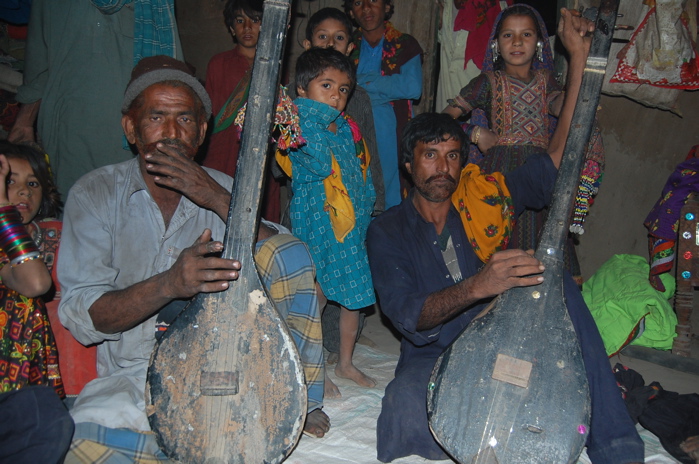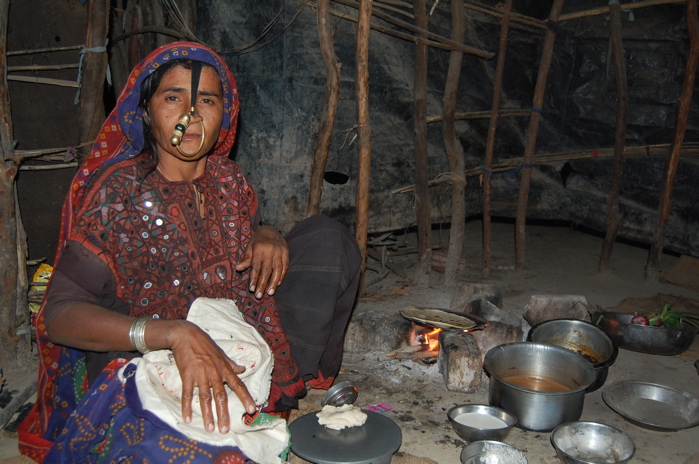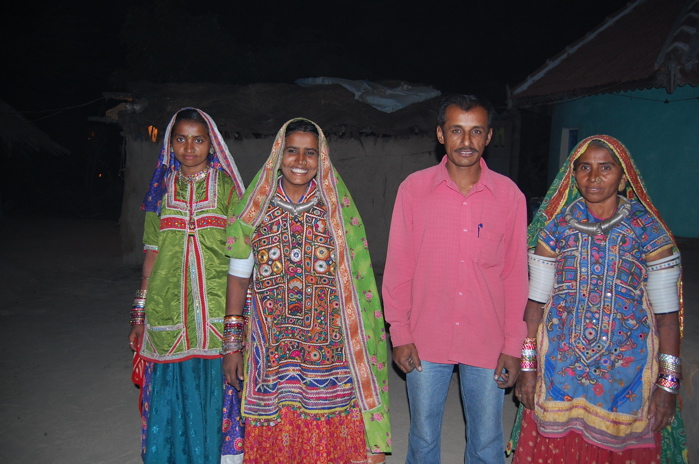
It is only a week or so since Benazir Bhutto was assassinated, and, in reading the Indian press that expresses such fear of greater instability in their neighboring enemy country, one tends to forget the incredible bonds that hold India and Pakistan together.
Stalin and I saw these strong ties over christmas in Kutch, a region that is geographically part of Sindh, a desert tribal heartland (and incidentally the homeland of Benazir Bhutto where she was buried). On this four day Christmas break, we also saw the power of community media, for Kutch is where Stalin and his colleagues at Drishti and the women’s organization KMVS have been doing community radio for ten years, in which local people have produced an extremely popular program that celebrates local arts and culture.
THE LAST MUSICIANS
This is Mitha Khan with his teacher and student. These three Muslim men are the last three singers in India of a form of Sufi devotional song called Waai. After bushwacking in a jeep for two hours across the vast desert, we arrived in Mitha Khan’s village, Bhagadia, just before dusk. Bhagadia is a Jat village, and the Jats are a Muslim nomadic tribe.

The women wear huge noserings that they have to tie up with their hair because of the weight, and they live in platform wooden houses. As night fell, we crowded into one of their mud huts and the three men treated us to what was quite simply the most extraordinary musical experience of my life. I know next to nothing about sufi music, so I won’t even attempt to describe it. What I will do is make an appeal that this kind of music be preserved. The community radio program already has. Ten years ago, Mr. Khan’s music was featured in the first radio show and broadcast across the state. A few years later, KMVS’ cultural cell made a nine hour recording of their music and have just produced a CD featuring it, the only studio recording of this dying musical tradition.
Mitha Khan showed his passport (which he must have gone to huge lengths to get) to Preeti, the immensely loved manager of the community radio program. The three men are desperate to go to villages that are only a couple hundred kilometers away in Pakistan. They want to play with the other musicians who play their style.They want to get their instruments fixed and get new ones—they’ve managed to preserve these last two guitar-like instruments for over sixty years since partition cut them off from their tribal brothers, when they somehow landed on this side of the border rather than the other.
Now that they have their passports, they only need Rs. 60,000 –about $1500—to make the trip. Music lovers or believers in cultural preservation can contact KMVS to contribute to this trip.
THE FAN OF THE CR PROGRAM

This guy is a truck driver who transports wood across the Rann, (desert) for use in making coal. We passed him on our way to mitha khan’s village, and he pulled over—maybe to gape at the foreigner. “who are you all?” he asked. Parmel, the radio producer with us, told him that we were associated with Ujjass Radio. Had he heard of it? “Yes, of course I know it. I’ve written you lots of letters! I love your programs!’ stalin has often said that the radio program is such a deep institution in the community that they have at least one volunteer or contact for programs in each of the 1000+ villages in Kutch. All India Radio, on whose airwaves they broadcast, once called them in amazement saying that the KMVS radio serial then being broadcast had gotten more audience letters than any other program in the station’s history, more than 800 letters—and this in an area with less than 1% female literacy.
RURAL SUCCESS STORIES
Habu Bijal is a former Community Radio producer and so we stopped in his village to say hi. How he’s currently making his living is fascinating. Kutch is over-run with a plant called the ‘crazy tree’ that was brought in to stop salinity in the grasslands but instead takes up all the ground water and stops anything else from growing. The government in the last year recently made it legal for villagers to cut down the ‘crazy tree’ to make charcoal. Habu Bijal has started a charcoal business.He’s bought a truck, and has three employees working for him. He makes almost $300 a month. In every village we went to, we saw three or four pits where people were making charcoal—building files, burying them in mud and dung, and then uncovering charcoal three days later. The next step for local environmentalists is to start a process of converting the land cleared of ‘crazy tree’ back into grasslands—this used to be one of the largest grasslands in asia, attracting herding communities from all over India. Maybe it will be one day soon again.

He probably takes inspiration from his mother, also pictured here. She’s a member of KMVS, one of the leaders of one of the most successful grassroots crafts cooperatives that made more than $1 million in sales. We’ll be talking to them as we work out how to make our own community video units sustainable.
Written by Jessica Mayberry, Founding Director of Video Volunteers.
Qaleen Baafi: Diminutive Art
Kashmir carpet is famous throughout the world. Germany is the largest consumer of Kashmiri carpet, the country’s cold winters make it an ideal destination for the use of Kashmir Shawls, rugs and carpets. Kashmiri carpets are considered to be the finest carpets in the world second only to Persian carpets.
The Rhythmic Tribal Culture
Bastar, in Chattisgarh State, India, is well known for their tribal population, and their unique, distinctive cultural heritage. In this area, the tradition of playing Madar has been going on since time immemorial.
